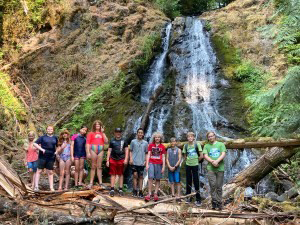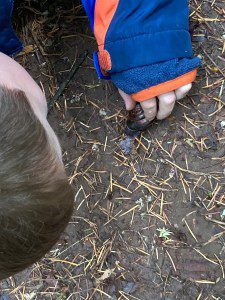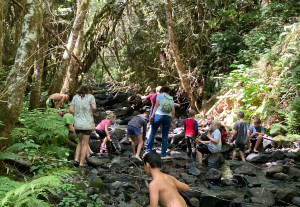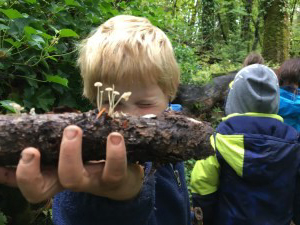Guest Blog Post by Neyssa Hays, with Outdoor Education Adventures
I was a young mom. My daughter was born when I was barely 18 years old, and I had so many lessons to learn about how to be a parent. One of those lessons was how to encourage a child to love being in nature. I grew up running around in the woods with my siblings; today our childhood experiences would probably be considered neglect by many people, but we loved it and I wanted my child to love being in nature, too. So, as soon as she was “old enough,” I packed her up and took her out for a hike. My goal: a secluded waterfall miles from the trailhead. Her goal? I don’t know; I didn’t stop to find out, but pushed to make it to the waterfall. She was miserable the whole way, and we never got there; she was exhausted and crying. My visions of a lovely picnic with my happy child playing in the mud next to a picturesque waterfall completely fell apart, and I was really sad. I could not understand why she didn’t love being outside the way I had at her age. Today, while she enjoys being outdoors sometimes, she has also told me that she is “pro indoors.”
I’ve learned so much about sharing nature with children since then. Together with some words of wisdom from our early childhood education team, Heidi Hoskins and Amy Nelson, I hope we can help you avoid making some common mistakes, and give you ideas for creating marvelous outdoor adventures with your family.
 1. Forget your goals. The waterfall, lake, cave, or whatever other really great thing you want to get to will still be there when your child is old enough to enjoy a long hike. Think of your outings as open-ended adventures and allow spontaneity to guide you.
1. Forget your goals. The waterfall, lake, cave, or whatever other really great thing you want to get to will still be there when your child is old enough to enjoy a long hike. Think of your outings as open-ended adventures and allow spontaneity to guide you.
2. Allow for many stops along the way. Your child is much more likely to love nature if they are allowed time to notice and appreciate it at their own pace. Engage with them about the things they notice, no matter how mundane it is to you. The world is new to them, and though you may have seen a thousand worms, slugs, and caterpillars already, they haven’t. Share in their excitement while doing your best to sound like it’s as exciting to you as it is to them.
3. Periodically stop to share with them the things you enjoy as well. Teacher Amy says, “Children will value what their adults value. So start noticing nature more and talk with them about what you’re noticing. Listen to the birds, feel the wind, notice how the air smells.”
 4. “Follow their lead,” says Teacher Heidi, “If they are not interested in something don’t push it [or try to] ‘make them understand.’” Even when they are interested in something, don’t continue teaching them about it past their natural engagement. When you notice they’re losing interest, quickly finish your last thoughts on it and move on. Usually, they just need time to think about what they just learned. You’ll be amazed to hear them telling someone else all about what they learned when you thought your chat was just in one ear and out the other.
4. “Follow their lead,” says Teacher Heidi, “If they are not interested in something don’t push it [or try to] ‘make them understand.’” Even when they are interested in something, don’t continue teaching them about it past their natural engagement. When you notice they’re losing interest, quickly finish your last thoughts on it and move on. Usually, they just need time to think about what they just learned. You’ll be amazed to hear them telling someone else all about what they learned when you thought your chat was just in one ear and out the other.
5. Model curiosity and use “I wonder” statements. You don’t always have to know the answer to things, and it’s often better to have questions that lead to more questions. People, including children, will trust what you do know more readily if you sometimes don’t know something and are brave enough to admit it. Both Teacher Amy and Teacher Heidi recommend using “I wonder” statements. For example, Teacher Amy says, “I wonder where that bird is flying to? I wonder what that squirrel is doing, digging in the ground? This is a great way to point out your observations, find out what they already know, and stoke their natural curiosity.”
 6. “Don’t ask too many questions,” emphasizes Teacher Heidi. It’s exhausting for a child to be constantly thinking through the answers, and many people are afraid to answer questions posed by “an expert,” lest they get it wrong. If your outing feels like a test, they’re not going to enjoy it very much. To find out what they know, start with some easy questions to which you know they already know the answer and let them expand on their ideas. Open questions such as, “What do you think?” allow them to put together what they already know without the pressure of being right or wrong. When they do answer, reward them by truly listening to their answer and respond with a positive affirmation, no matter how outlandish their thought may seem to you. “Wow, that is a really interesting idea! I wonder …” is always better than filling them with facts at that moment. There will always be other opportunities to correct misunderstandings.
6. “Don’t ask too many questions,” emphasizes Teacher Heidi. It’s exhausting for a child to be constantly thinking through the answers, and many people are afraid to answer questions posed by “an expert,” lest they get it wrong. If your outing feels like a test, they’re not going to enjoy it very much. To find out what they know, start with some easy questions to which you know they already know the answer and let them expand on their ideas. Open questions such as, “What do you think?” allow them to put together what they already know without the pressure of being right or wrong. When they do answer, reward them by truly listening to their answer and respond with a positive affirmation, no matter how outlandish their thought may seem to you. “Wow, that is a really interesting idea! I wonder …” is always better than filling them with facts at that moment. There will always be other opportunities to correct misunderstandings.
 7. Let them take risks. As we’ve written before, calculated risk taking is very good for childhood development. It helps build their bodies and their self-confidence, and teaches them invaluable lessons that can help keep them safe. So let them climb a tree, jump from boulder to boulder, or cross a slippery stream. The mishaps, bumps, bruises, and scrapes will become part of the adventure story.
7. Let them take risks. As we’ve written before, calculated risk taking is very good for childhood development. It helps build their bodies and their self-confidence, and teaches them invaluable lessons that can help keep them safe. So let them climb a tree, jump from boulder to boulder, or cross a slippery stream. The mishaps, bumps, bruises, and scrapes will become part of the adventure story.

8. Take them out at dawn, dusk, or the middle of the night. Not only is there great beauty to be held at these times, many animals come out during the twilight or full dark hours. It’s very exciting to hide in the bushes and watch a raccoon scramble down a tree or a skunk crossing only a few feet in front of you as it leaves its burrow. Our senses are challenged and heightened in the dark. Consider playing variations on hide and seek in the dark, or simply lay on your backs, watching the stars and listening to the world around you.
9. Bring nature to you. Teacher Heidi recommends gardening as “a quick and easy way to build connection” with nature. Teacher Amy adds, “Invite nature into your yard! Put up a bird feeder, birdhouse or birdbath, build a bug hotel, start a compost pile, get a bat box! These small actions can make a big impact by creating a connection with nature right outside your door.” Even if you live in an apartment, you can bring nature closer to you by keeping a houseplant, an aquarium, or a kitchen-counter herb garden.

Enjoy the journey with your kids, and keep it light.
10. Keep your lessons light. Climate change, plastics in the ocean, invasive species, overpopulation, extinction of other species … the human-caused environmental issues are far too heavy a burden for young children, and without any concrete ways of making a positive change, this can be a very painful and frustrating experience for them. Generally speaking, avoid these lessons until they’re at least 8 years old. Obviously, they don’t live in a bubble and sometimes they will become aware of negative information before you’re ready. If they start the conversation with you, don’t dismiss their concerns, but answer their questions in as honest of terms as you can without making it sound scary.
Most importantly, remember to enjoy the journey as you head outside with your family to Play, Adventure, and Learn!
Learn more about Outdoor Education Adventures on their website www.outdooredadventures.com

ABOUT THE AUTHOR— NEYSSA HAYS
Neyssa holds a degree in Fisheries and Wildlife Sciences from Oregon State University and a degree in Russian from Portland State University. She has worked in the natural resources field since 2004 as a park ranger, naturalist, and fisheries biologist assistant as well as an educator for the Oregon Zoo and Portland Public Schools.
Neyssa grew up in various small towns in north Oregon, from Baker City to Carlton, running around in the woods getting muddy and eating wild plants. She lived in Portland for most of her adult life before returning to Carlton with her husband and two children in 2014. Her time in Portland solidified her love of the outdoors and convictions that time in nature is healing. She believes firmly that all people should have lots of wilderness time in their lives.


